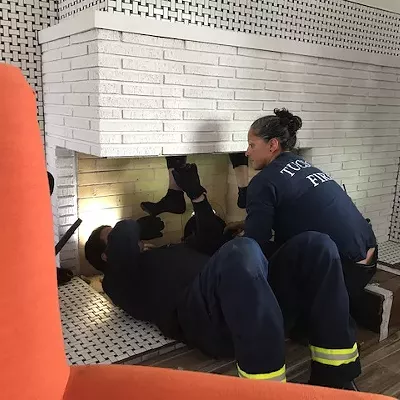Journalists jousted for interviews. A TV reporter outran a print reporter to the stand of the Tohono O'odham woman who makes frybread outside the newly celebrated mortuary chapel. A man wearing a New York Times badge wandered outside the mortuary gates and peered in at the workers who were steam-cleaning the green spray paint that vandals had used to violate the sacred space.
Another Tohono O'odham woman kept an eye on the action from her food stand on the other side of the parking lot, a bit too far away to attract the press.
"Nothing's back to normal," she said. "Oh, no. The reporters and cops are all here."
Causing the commotion were three successive acts of vandalism to the chapel, a small, until-now unprotected building just to the west of the main church. None of the 18th-century mission church's priceless historic art was hurt, but the news of spray-painting and the smashing of santos statues was still shocking.
"It's awful, it's really sick," lamented Bernard "Bunny" Fontana, a retired research librarian, the historian of the mission church and a member of the Patronato San Xavier, the nonprofit that does fund-raising for the restoration of the church, prized for its elaborate Mexican Baroque paintings.
Bob Vint, the architect who's been guiding that much-publicized restoration, said he almost fell out of bed when he first heard the news. Early on the morning of February 13, a TV reporter awakened him with a phone call to report--erroneously--that the statues of San Xavier had been destroyed.
"I got a scare," said Vint, who right now is overseeing replacement of some 1970s-era reproduction finials on the church roof. "Fortunately, it was not as bad as it sounded. The vandals did not hit the church. They destroyed little plaster of paris statues from the gift shop."
Fred Allison, a spokesman for the Roman Catholic Diocese of Tucson, said that the pious regularly leave santos in the chapel in memory of their dead loved ones, or as part of a petition to a saint. "It's part of the cultural expression of faith," he explained. On the vandals' first outing, February 12, the miscreants also spray-painted the little chapel with green paint. More statues were broken up in the second strike February 18, and the third time around, on February 19, somebody set fire to a statue that had been placed in a makeshift shrine meant to take the chapel's place temporarily. So far, police have made no arrests.
Church officials this week announced new security measures. "We have a short-term and a long-term plan," Allison said. Tohono O'odham police are on hyper-alert, and a pair of wrought-iron gates already being forged will soon replace the chapel's wooden doors, which have always been left open to allow candles to burn inside. Long-term security systems, possibly including video cameras and motion detectors, will be put in place, mimicking the technology that already protects the main church.
"The mortuary was built at the same time" as the main basilica, in 1797, said Vint, "but it was never decorated like the main church." What the architect calls the plain "perfect cube of masonry" served as a mortuary in its first century, a place where bodies were prepared for burial. The bodies of two early Franciscan priests lie under its floor.
But in 1906, when Henry Granjon, the French-born bishop of Tucson, began the first restoration of the church, he converted the mortuary into a chapel for people's private worship, Allison said.
Granjon also took the opportunity to make new finials for the church roof to replace the 25 originals, which had crumbled away by the end of the 19th century. But homesick, perhaps, for France, Granjon had the 3-foot-high ornaments constructed in the French style. Along about the 1970s, when the tide turned toward more faithful restoration, architect James Gresham was commissioned to create accurate reproduction finials in the old Spanish style. Vint said that during the recent reconstruction studies, he discovered that the 300-pound concrete finials could pose a deadly danger should they fall--they could damage the art or even "squash someone."
New fiberglass replacements, cast on Gresham's historically accurate finials, are going up right now. The project brings a little measure of satisfaction to a Patronato leadership badly shaken by the vandalism. President Lorraine Drachman said that Danny Morales, a principal restorer, suggested selling the 1970s-era finials to Patronato members in exchange for a $1,200 donation. Heavy as they are, the finials went like hotcakes, Drachman said.
"We raised $30,000," she said proudly. "It was a highly successful little money-making scheme," with the cash going right into the restoration pot. The finials are spreading out all over Tucson. One Foothills woman put hers in her garden, Drachman said. Dorothy Finley's finial has gone onto a pedestal newly built in the lobby of Finley Distribution Company.
The finial financial scheme comes not a minute too soon. At first, when the vandalism erupted, "for a few days we were disoriented," Drachman said. "At this point we're getting serious. We're getting this (security) taken care of right away."














